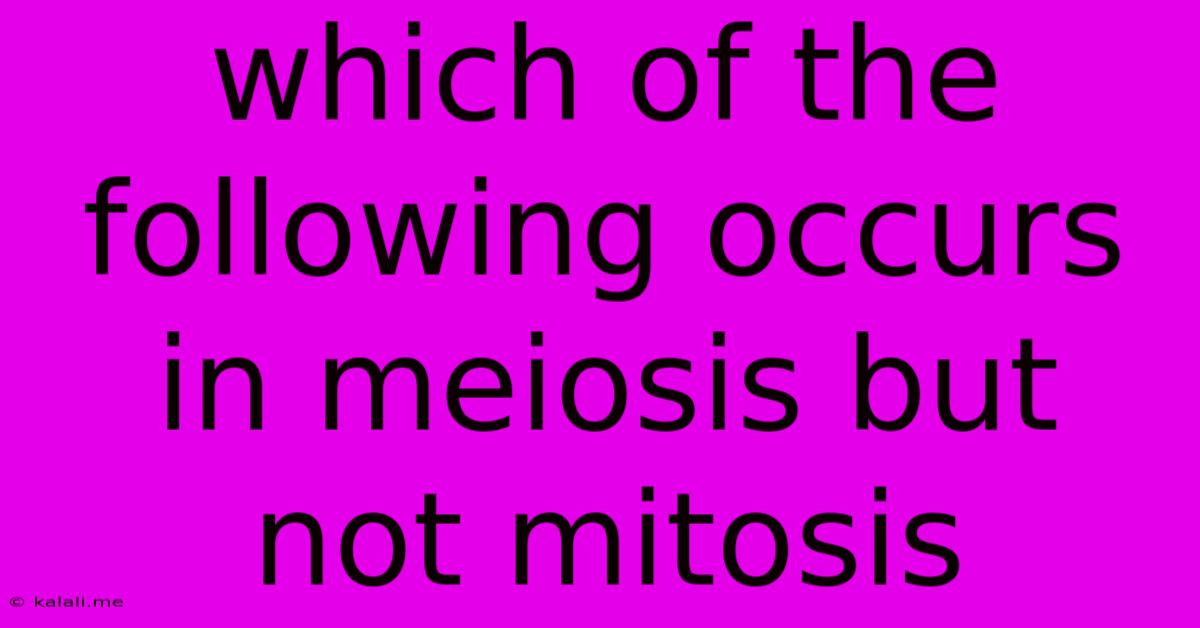Which Of The Following Occurs In Meiosis But Not Mitosis
Kalali
Jun 13, 2025 · 3 min read

Table of Contents
Which of the Following Occurs in Meiosis but Not Mitosis? Understanding the Key Differences
Meiosis and mitosis are both types of cell division, but they serve vastly different purposes. Understanding the distinctions between these processes is crucial for grasping fundamental concepts in biology. This article will delve into the key differences, highlighting the processes that occur uniquely in meiosis. Specifically, we'll explore the core differences that set meiosis apart from mitosis, addressing the question: which processes occur exclusively in meiosis?
Meta Description: This article explores the key differences between meiosis and mitosis, focusing on processes unique to meiosis, including homologous chromosome pairing, crossing over, and reduction division. Learn how these processes contribute to genetic diversity.
The Core Differences: Meiosis vs. Mitosis
Both meiosis and mitosis are crucial for the life cycle of organisms, but they achieve different goals through distinct mechanisms. Mitosis is responsible for cell growth and repair, producing two genetically identical daughter cells from a single parent cell. Meiosis, on the other hand, is involved in sexual reproduction, generating four genetically diverse haploid cells (gametes) from a single diploid parent cell. This fundamental difference leads to several key distinctions in their processes.
Processes Unique to Meiosis
Several crucial events happen only during meiosis, directly contributing to the genetic variation that is vital for evolution and adaptation. These include:
-
Homologous Chromosome Pairing (Synapsis): In meiosis I, homologous chromosomes – one inherited from each parent – pair up to form a structure called a tetrad. This pairing is absent in mitosis, where chromosomes remain individual. This synapsis is essential for the next step.
-
Crossing Over (Recombination): Following synapsis, homologous chromosomes exchange segments of DNA in a process called crossing over. This recombination shuffles genetic material between homologous chromosomes, creating new combinations of alleles and significantly increasing genetic diversity. Mitosis lacks this crucial step; sister chromatids may be similar, but they lack the exchange of genetic material between homologous pairs.
-
Reduction Division (Meiosis I): Meiosis involves two rounds of division: Meiosis I and Meiosis II. The crucial difference lies in Meiosis I, where homologous chromosomes separate, reducing the chromosome number by half. This reduction from diploid (2n) to haploid (n) is unique to meiosis and essential for producing gametes with half the chromosome number of the parent cell. Mitosis only has one division, maintaining the diploid chromosome number.
-
Independent Assortment: During meiosis I, the homologous chromosome pairs align randomly at the metaphase plate. This random alignment leads to independent assortment of chromosomes, further increasing genetic variation in the resulting gametes. This random arrangement does not occur in mitosis.
Consequences of Meiosis-Specific Processes
The unique processes of meiosis have profound consequences:
-
Genetic Diversity: Crossing over and independent assortment generate significant genetic variation within a population. This diversity is the raw material upon which natural selection acts, driving adaptation and evolution.
-
Sexual Reproduction: The reduction in chromosome number during meiosis I is critical for sexual reproduction. When two haploid gametes fuse during fertilization, the resulting zygote restores the diploid chromosome number, inheriting a unique combination of genes from both parents.
Conclusion
In summary, several processes distinguish meiosis from mitosis. Homologous chromosome pairing, crossing over, reduction division, and independent assortment are all unique to meiosis and are fundamental to the creation of genetically diverse gametes, ultimately driving the evolution of sexually reproducing organisms. Understanding these differences is essential for comprehending the complexities of genetics and the processes that shape life on Earth.
Latest Posts
Latest Posts
-
Least Common Multiple Of 9 And 13
Jun 14, 2025
-
Does Case Western Require Official Score Reports
Jun 14, 2025
-
Crime And Deviance Refer To The Same Actions And Behaviors
Jun 14, 2025
-
Theorists Who Emphasize Plasticity Believe That
Jun 14, 2025
-
How To Write 1650 On A Check
Jun 14, 2025
Related Post
Thank you for visiting our website which covers about Which Of The Following Occurs In Meiosis But Not Mitosis . We hope the information provided has been useful to you. Feel free to contact us if you have any questions or need further assistance. See you next time and don't miss to bookmark.